Garmin SL30 NAV, SL30 COMM User Manual

Apollo
Model SL30 NAV/COMM
Installation Manual
August 2003 560-0404-03a
2003 Garmin AT, Inc. All rights reserved. Printed in the USA
No part of this document may be transmitted, reproduced, or copied in any form or by any means without the prior written consent of Garmin AT, Inc. Due to Garmin AT’s commitment to constantly improve the quality and performance of our products, information contained in this document is subject to change without notice.
Garmin AT, Inc. and Apollo are registered trademarks of Garmin AT, Inc.
Garmin AT, Inc. |
2345 Turner Rd. SE |
PO Box 13549 |
Salem, OR 97302 |
Salem, OR 97309 |
USA |
Phone 503.581.8101 |
|
800.525.6726 |
|
In Canada 800.654.3415 |
|
Fax: 503.364.2138 |
|
HISTORY OF REVISIONS
Revision |
Date |
Description |
-- |
11/16/99 |
Initial release (EN6278). |
01 |
2/10/00 |
Added interface wiring diagrams, refined post installation |
|
|
checkout procedures. |
02 |
8/2/01 |
New mounting tubes, dual SL30’s, DST info to Apollo GX (EN |
|
|
6949). SW Version 1.2 |
03 |
2/21/02 |
Added helicopter environmental qualification information. |
03a |
8/26/03 |
Changed logo and added JTSO information. |
IMPORTANT NOTE
“The conditions and tests required for TSO approval of this article are minimum performance standards. It is the responsibility of those desiring to install this article on or within a specific type or class of aircraft to determine that the aircraft operating conditions are within TSO standards. The article may be installed only if further evaluation by the applicant documents an acceptable installation and is approved by the Administrator.” Follow installation recommendations as noted in AC20-67B, Airborne VHF Communications Equipment Installations.
Source: FAA TSO-C34e, TSO-C36e, TSO-C37d, TSO-C38d, TSO-
C40c, TSO-C66c, and TSO-C128.
ORDERING INFORMATION
To receive additional copies of this publication, order part # 560-0404-03a, Apollo SL30 NAV/ COMM Installation Manual.
REFERENCE PUBLICATIONS
Following are other publications referenced in this guide.
Apollo SL30 NAV/ COMM Operation Manual, order part # 560-0403-xx.

NOTES

|
Table of Contents |
TABLE OF CONTENTS |
|
SECTION 1 - INTRODUCTION ................................................................................................ |
1 |
ABOUT THIS MANUAL ..................................................................................................................... |
1 |
APOLLO SL30 DESCRIPTION ............................................................................................................ |
1 |
FEATURES ........................................................................................................................................ |
2 |
GENERAL FEATURES.................................................................................................................................................. |
2 |
NAVIGATION RADIO FEATURES ................................................................................................................................. |
2 |
COMM RADIO FEATURES ........................................................................................................................................... |
3 |
PHYSICAL SPECIFICATIONS ........................................................................................................................................ |
3 |
NAV RADIO PERFORMANCE SPECIFICATIONS ........................................................................................................... |
3 |
COMM RADIO PERFORMANCE SPECIFICATIONS.......................................................................................................... |
3 |
SYSTEM INTERFACES........................................................................................................................ |
4 |
NAVIGATION RECEIVER ............................................................................................................................................. |
4 |
COMM TRANSCEIVER................................................................................................................................................. |
4 |
SERIAL INTERFACE .................................................................................................................................................... |
4 |
REGULATORY COMPLIANCE............................................................................................................. |
4 |
UNPACKING THE EQUIPMENT ........................................................................................................... |
5 |
PACKAGE CONTENTS ....................................................................................................................... |
5 |
OTHER REQUIRED MATERIALS......................................................................................................... |
6 |
SPECIAL TOOLS REQUIRED............................................................................................................... |
6 |
LICENSE REQUIREMENTS ................................................................................................................. |
7 |
SECTION 2 - INSTALLATION.................................................................................................. |
9 |
PRE-INSTALLATION INFORMATION................................................................................................... |
9 |
INSTALLATION OVERVIEW ............................................................................................................... |
9 |
INSTALLATION CONSIDERATIONS..................................................................................................... |
9 |
MOUNTING CONSIDERATIONS.................................................................................................................................... |
9 |
MINIMUM SYSTEM CONFIGURATION.......................................................................................................................... |
9 |
EQUIPMENT MOUNTING ................................................................................................................. |
10 |
MOUNTING TUBE INSTALLATION ............................................................................................................................. |
10 |
UNIT INSERTION....................................................................................................................................................... |
12 |
UNIT REMOVAL ....................................................................................................................................................... |
12 |
ELECTRICAL CONNECTIONS ........................................................................................................... |
14 |
POWER ..................................................................................................................................................................... |
14 |
AVIONICS OUTPUTS ................................................................................................................................................. |
14 |
SERIAL INTERFACE .................................................................................................................................................. |
14 |
SPEAKER AND HEADPHONE OUTPUTS ...................................................................................................................... |
14 |
MICROPHONE INPUTS............................................................................................................................................... |
15 |
TRANSMIT KEY INPUT.............................................................................................................................................. |
15 |
INTERCOM SELECTOR SWITCH ................................................................................................................................. |
15 |
REMOTE FLIP/FLOP INPUT........................................................................................................................................ |
15 |
ANTENNA INSTALLATION AND CONNECTIONS ............................................................................... |
15 |
COMM AND NAV ANTENNAS.................................................................................................................................... |
15 |
USE OF SPLITTER AND COMBINER............................................................................................................................ |
16 |
EQUIPMENT INTERFACE ................................................................................................................. |
17 |
LIMITATIONS ON USING A COMPOSITE SIGNAL .............................................................................. |
33 |
LIMITATIONS ON DISTANCE, SPEED, AND TIME INFORMATION....................................................... |
33 |
POST INSTALLATION CHECKOUT.................................................................................................... |
33 |
MOUNTING / WIRING CHECK ................................................................................................................................... |
33 |
Apollo SL30 Installation Manual |
i |

Table of Contents
SETUP AND CHECKOUT............................................................................................................................................ |
33 |
FINAL SYSTEM CHECK ............................................................................................................................................ |
37 |
INSTRUCTIONS FOR CONTINUED AIRWORTHINESS .......................................................................... |
40 |
SECTION 3 - SPECIFICATIONS ............................................................................................. |
41 |
ELECTRICAL ................................................................................................................................... |
41 |
PHYSICAL ....................................................................................................................................... |
41 |
ENVIRONMENTAL ........................................................................................................................... |
41 |
AVIONICS OUTPUTS ........................................................................................................................ |
42 |
NAV RECEIVER PERFORMANCE ..................................................................................................... |
43 |
VOR ....................................................................................................................................................................... |
43 |
LOCALIZER.............................................................................................................................................................. |
43 |
GLIDESLOPE ............................................................................................................................................................ |
44 |
OBS RESOLVER ...................................................................................................................................................... |
44 |
COMPOSITE OUTPUT................................................................................................................................................ |
44 |
COMM RECEIVER PERFORMANCE ................................................................................................... |
45 |
COMM TRANSMITTER PERFORMANCE............................................................................................. |
45 |
INTERCOM PERFORMANCE .............................................................................................................. |
46 |
CONTROL INPUTS............................................................................................................................ |
46 |
ANTENNA REQUIREMENTS.............................................................................................................. |
46 |
COMM ANTENNA..................................................................................................................................................... |
46 |
NAV ANTENNA....................................................................................................................................................... |
46 |
SERIAL INTERFACE ......................................................................................................................... |
47 |
REAR CONNECTOR PINOUT............................................................................................................. |
47 |
SECTION 4 - LIMITATIONS ................................................................................................... |
49 |
INSTALLATION ................................................................................................................................ |
49 |
COMPUTATION RATES .................................................................................................................... |
49 |
OPERATIONAL................................................................................................................................. |
49 |
APPENDIX A - TROUBLESHOOTING .................................................................................. |
51 |
CONTACTING THE FACTORY FOR ASSISTANCE................................................................................ |
52 |
APPENDIX B - PERIODIC MAINTENANCE ........................................................................ |
53 |
VOR CHECKS ................................................................................................................................. |
53 |
EQUIPMENT CALIBRATION.............................................................................................................. |
53 |
REFERENCE OSCILLATOR (COMM ONLY) ................................................................................................................ |
53 |
CLEANING THE FRONT PANEL......................................................................................................... |
53 |
APPENDIX C - ENVIRONMENTAL QUALIFICATIONS................................................... |
55 |
APPENDIX D - ACCESSORIES ............................................................................................... |
57 |
FROM GARMIN AT, INC. ................................................................................................................. |
57 |
APPENDIX E - SERIAL INTERFACE SPECIFICATIONS ................................................. |
59 |
INPUT COMMANDS.......................................................................................................................... |
59 |
OUTPUT MESSAGES ........................................................................................................................ |
59 |
DATA FORMAT................................................................................................................................ |
60 |
DEFAULT MESSAGE OUTPUT .......................................................................................................... |
60 |
MESSAGE FORMATS........................................................................................................................ |
60 |
ii |
Apollo SL30 Installation Manual |

|
Table of Contents |
MESSAGE DEFINITIONS .................................................................................................................. |
61 |
INPUT MESSAGES..................................................................................................................................................... |
61 |
REMOTE VOR LIST.................................................................................................................................................. |
62 |
REMOTE LOCALIZER LIST ........................................................................................................................................ |
64 |
REQUEST DATA OUTPUT.......................................................................................................................................... |
66 |
SET ACTIVE VOR/LOC FREQUENCY AND RECEIVER FUNCTION ............................................................................. |
67 |
SET STANDBY VOR/LOC FREQUENCY AND RECEIVER FUNCTION .......................................................................... |
67 |
SET STANDBY COMM FREQUENCY AND TRANSCEIVER FUNCTION......................................................................... |
68 |
SET ACTIVE COMM FREQUENCY AND TRANSCEIVER FUNCTION............................................................................ |
68 |
SET NAV AUDIO MODE........................................................................................................................................... |
69 |
SET OMNI-BEARING SELECT (OBS) VALUE............................................................................................................. |
69 |
DME SENSOR INPUT................................................................................................................................................ |
70 |
OUTPUT MESSAGES........................................................................................................................ |
70 |
RESET STATUS ......................................................................................................................................................... |
70 |
CDI, GSI, AND RELATED FLAGS.............................................................................................................................. |
71 |
DECODED OBS SETTING .......................................................................................................................................... |
72 |
RADIAL FROM ACTIVE VOR.................................................................................................................................... |
72 |
RADIAL FROM STANDBY VOR ................................................................................................................................ |
72 |
DECODED STATION IDENTIFIER................................................................................................................................ |
73 |
COMMUNICATIONS ERROR....................................................................................................................................... |
73 |
NAV RECEIVER STATUS.......................................................................................................................................... |
74 |
NAV AUDIO MODE ................................................................................................................................................. |
74 |
NAV MICROCONTROLLER SOFTWARE VERSION...................................................................................................... |
75 |
NAV DSP SOFTWARE VERSION .............................................................................................................................. |
75 |
ADC DATA OUTPUT ................................................................................................................................................ |
75 |
COMM TRANSCEIVER STATUS.................................................................................................................................. |
76 |
COMM SOFTWARE VERSION..................................................................................................................................... |
76 |
Apollo SL30 Installation Manual |
iii |

Table of Contents |
|
LIST OF TABLES |
|
TABLE 1 - PACKAGE CONTENTS........................................................................................................ |
5 |
TABLE 2 - COMM INTERFACE CONNECTOR PINOUT ........................................................................ |
47 |
TABLE 3 - REAR PANEL CONNECTOR PINOUT ................................................................................. |
48 |
TABLE 4 - TROUBLESHOOTING GUIDE ............................................................................................ |
51 |
TABLE 5 - DATA OUTPUT REQUESTS .............................................................................................. |
66 |
LIST OF ILLUSTRATIONS |
|
FIGURE 1 - SL30 FRONT PANEL ........................................................................................................ |
2 |
FIGURE 2 - FULL STACK MOUNTING TUBE SPACING....................................................................... |
11 |
FIGURE 3 - CAM LOCK POSITIONING............................................................................................... |
12 |
FIGURE 4 - MOUNTING FRAME ASSEMBLY ..................................................................................... |
13 |
FIGURE 5 - CABLE ROUTING ........................................................................................................... |
13 |
FIGURE 6 - REAR COAX CONNECTOR ASSEMBLY ........................................................................... |
16 |
FIGURE 7 - SL30 COMM WIRING DIAGRAM .................................................................................... |
18 |
FIGURE 8 - SL30 COMM TYPICAL AUDIO PANEL CONNECTIONS .................................................... |
19 |
FIGURE 9 - SL30 NAV POWER AND AUDIO CONNECTIONS ............................................................ |
20 |
FIGURE 10 – SL30 TO APOLLO GX50/60 CONNECTIONS ................................................................ |
20 |
FIGURE 11 - SL30 - GX50/60 - MX20 CONNECTIONS .................................................................... |
21 |
FIGURE 12 - SL30 NAV TO MID-CONT MD200-306/307............................................................... |
22 |
FIGURE 13 - SL30 NAV TO MID-CONT MD200-302/303 CONNECTIONS ....................................... |
23 |
FIGURE 14 - SL30 NAV AND ACU TO MID-CONT MD200-306/307.............................................. |
24 |
FIGURE 15 - SL30 NAV TO STEC IND-351A CONNECTIONS ........................................................ |
25 |
FIGURE 16 - SL30 NAV TO BENDIX/KING KN72/203/204/208/208A/209/209A WIRING ............. |
26 |
FIGURE 17 - SL30 NAV TO BENDIX/KING KI202/206/525A/KPI552 WIRING............................... |
27 |
FIGURE 18 - SL30 NAV TO SANDEL DISCRETE CONNECTIONS....................................................... |
28 |
FIGURE 19 - SL30 NAV TO SANDEL SN3308 CONVERTER CONNECTIONS ..................................... |
29 |
FIGURE 20 - SL30 TO SPERRY RD 550A AND RD650 WIRING ....................................................... |
30 |
FIGURE 21 - SL30 TO COLLINS 331A-6P, 331A-9G, AND PN-101 WIRING .................................... |
31 |
FIGURE 22 - SL30 TO CENTURY NSD 360A AND NSD 1000 WIRING............................................. |
32 |
FIGURE 23 - UNIT DIMENSIONS....................................................................................................... |
42 |
iv |
Apollo SL30 Installation Manual |

Introduction
SECTION 1 - INTRODUCTION
ABOUT THIS MANUAL
This manual describes the installation of the Apollo SL30 Nav/Comm units. It is intended for use by persons certified by the Federal Aviation Administration (FAA) to install aircraft navigation devices. It includes installation and checkout procedures for the SL30 unit to standards described in FAA advisory circulars AC 20-67B (for Comm).
|
|
Provides an introduction to the Apollo SL30 unit. TSO certification information |
|
Section 1 |
|
||
|
is also included in this section. |
||
|
|
||
|
|
Includes installation and checkout procedures. |
|
Section 2 |
|
||
|
|
|
|
|
|
Includes complete specifications. |
|
Section 3 |
|
||
|
|
|
|
|
|
Includes limitations for the equipment and installation. |
|
Section 4 |
|
||
|
|
|
|
|
|
|
Includes troubleshooting information. |
Appendix A |
|
||
|
|
||
|
|
|
Includes periodic maintenance requirements. |
Appendix B |
|
||
|
|
||
|
|
|
Includes the environmental qualification form. |
Appendix C |
|
||
|
|
||
|
|
|
Includes information on accessories. |
Appendix D |
|
||
|
|
||
|
|
|
Includes serial data specifications. |
Appendix E |
|
||
|
|
||
APOLLO SL30 DESCRIPTION
The Apollo SL30 includes a 760-channel VHF Comm transceiver and 200-channel VOR/LOC/GS navigation receiver with DME display.
The Apollo SL30 is a member of the Apollo slimline series which includes the SL10/15 Audio Selector Panels, SL40 Comm, SL50 GPS, SL60 GPS/Comm, and SL70 Transponder.
Apollo SL30 Installation Manual |
1 |
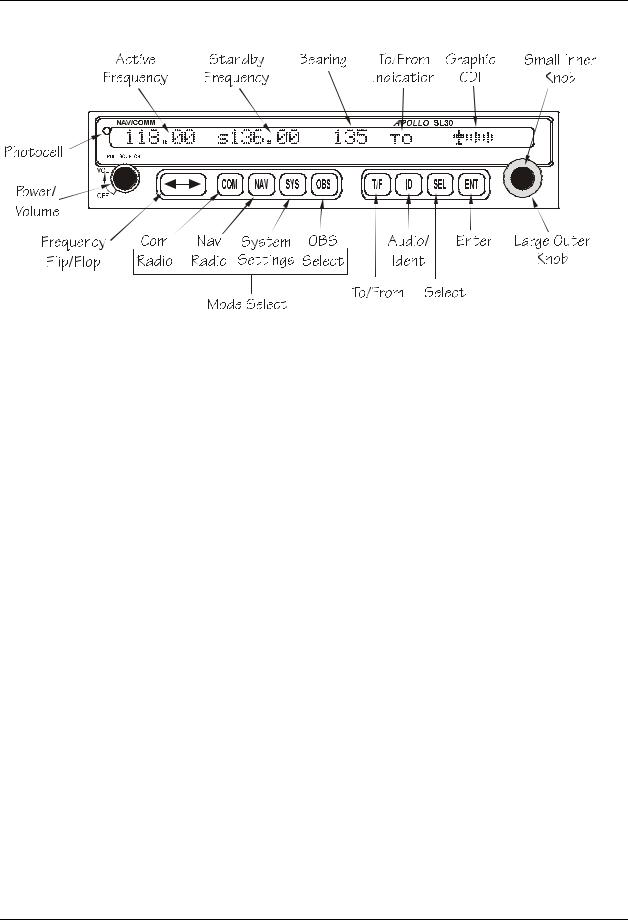
Introduction
Figure 1 - SL30 Front Panel
FEATURES
GENERAL FEATURES
•32 character high-intensity alphanumeric LED display
•Sunlight readable full alphanumeric display
•Automatic display intensity
•Back-lit buttons
•200 channel memory (stored alphabetically)
•Remote frequency flip-flop input pin
NAVIGATION RADIO FEATURES
•200 channel Nav with solid state DSP technology
•VOR/Localizer and Glideslope receivers
•Built-in VOR/Localizer converter
• Frequency range: |
VOR |
108.00 – 117.95 MHz |
|
Localizer |
108.00 – 111.95 MHz |
|
Glideslope |
328.60 – 335.40 MHz |
•Digitally decoded OBS setting
•Manual selection of back course approach
•Automatic display of station ID by decoding Morse code
•Interfaces to most CDI (w/resolver), HSI, and autopilot systems
•VOR receiver displays To or From radial of the active channel
•VOR monitor displays From radial of the standby channel
•Back course annunciator output
•LOC enable annunciator output
2 |
Apollo SL30 Installation Manual |

Introduction
•Internal RF diplexor
•Active and standby flip/flop frequencies
•DME tuning and data display
COMM RADIO FEATURES
•760 communications channels
•Frequency range 118 to 136.975 MHz
•Active and standby flip/flop frequencies
•Volume control
•Tunes to National Weather Service broadcasts
•Transmit status indicator
•Frequency monitor function (listens to standby while monitoring active)
•Emergency channel menu
•Squelch test function
•Stuck Mic time-out
•12 watt audio amplifier
•Includes two-place VOX intercom
PHYSICAL SPECIFICATIONS
•1.3"(H) x 6.25" (W) x 10.5" (D)
•Weight 2.25 lbs. (unit only)
•Depth 11.452 inches (29.09cm) behind panel, including mounting frame and connectors
NAV RADIO PERFORMANCE SPECIFICATIONS
•Input voltage range 10 to 40 VDC
•Operating temperature range –20ºC to +55ºC
•Certified TSO C34e/JTSO C34e (Glideslope receive)
•Certified TSO C36e/JTSO C36e (ILS Localizer receive)
•Certified TSO C40c/JTSO 2C40c (VOR receive)
•Certified TSO C66c/JTSO 2C66b (DME display)
COMM RADIO PERFORMANCE SPECIFICATIONS
•Input voltage range 10 to 40 VDC
•Operating temperature range –20ºC to +55ºC
•Transmit power 8 watts (Carrier Power)
•Certified TSO C37d/JTSO 2C37e (Comm transmitting)
•Certified TSO C38d/JTSO 2C38e (Comm receiving)
•Certified TSO C128/JTSO 2C128 (stuck mic)
Apollo SL30 Installation Manual |
3 |

Introduction
SYSTEM INTERFACES
NAVIGATION RECEIVER
The SL30 can be installed in several configurations based upon individual requirements. This includes with or without an external course deviation indicator. The CDI may be discrete, serial, or composite.
COMM TRANSCEIVER
For standalone installations, the Comm requires connections to:
•a standard Comm antenna
•a microphone (or microphones)
•a speaker or headphone
•power input
These items may be installed dedicated to the SL30 Comm, or by connection to an audio panel. The system can be configured to mix the NAV audio with the Comm audio if no external audio panel is used.
SERIAL INTERFACE
•DME – Distance Measure Equipment
•SL/GX – GPS products
•MX – Multi-Function Display
REGULATORY COMPLIANCE
The Apollo SL30 is designed and tested to meet the following TSOs/JTSOs: FAA TSO-C37d/JTSO 2C37e for Comm transmit
FAA TSO-C38d/JTSO 2C38e for Comm receive
FAA TSO-C128/JTSO 2C128 for unintentional transmission (stuck mic) FAA TSO-C34e/JTSO C34e for ILS Glideslope receive
FAA TSO-C36e/JTSO C36e for ILS Localizer receive FAA TSO-C40c/JTSO 2C40c for VOR receive
FAA TSO-C66c/JTSO 2C66b for DME display
The Apollo SL30 complies with the FCC requirements specified in:
CFR 47, Part 87, Aviation Services, Subpart D, Technical Requirements
The Apollo SL30 complies with the FCC requirements specified in:
CFR 47, Part 15, Radio Frequency Devices, Subpart B, Unintentional Radiators
The Apollo SL30 software is designed and tested to RTCA/DO-178B, level C and ED-12B, level C.
Note: Unauthorized changes or modifications to the SL30 may void the compliance to required regulatory agencies and authorization for continued equipment usage.
4 |
Apollo SL30 Installation Manual |

Introduction
UNPACKING THE EQUIPMENT
Carefully unpack the equipment. Visually inspect the package contents for any evidence of shipping damage. Retain all shipping containers and packaging material in case reshipment is necessary.
PACKAGE CONTENTS
As shipped from the Garmin AT factory, the Apollo SL30 package includes most items necessary for installation other than supplies normally available at the installation shop, such as wire and cable ties, and required input and output equipment. The standard items included in the package are listed in Table 1.
Table 1 - Package Contents
Part # |
Description |
Qty |
430-6040-3xx |
SL30 NAV/COMM |
1 |
Install kits |
Part number: 424-2006-300 |
|
|
|
|
162-1575 |
15-pin d-sub connector shell |
1 |
162-1577 |
37-pin d-sub connector shell |
1 |
162-1008 |
Right angle coax plug |
2 |
202-0001 |
Cable tie |
2 |
204-0037 |
Edge grommet |
6" |
204-2100 |
Shoulder bushing |
4 |
221-0400 |
4-40 x 1/4 SS pan head Phillips machine screw with lock |
8 |
|
washer |
|
224-0404 |
4-40 x 1/4 SS flat head Phillips machine screw |
4 |
245-0027 |
Crimp contact for d-sub, 20 to 24 awg wire |
50 |
310-5181-xx or |
Mounting frame |
1 |
310-5197-xx |
NOTE: Only 310-5197-xx is qualified for helicopter use. |
|
310-5192-xx |
Connector mounting plate |
1 |
998-0048 |
3/32 hex driver |
1 |
Manual kits |
Part number: 564-0064-300 |
-4xx |
|
|
|
560-0403-xx |
SL30 User’s Manual |
1 |
560-0404-xx |
SL30 Installation Manual |
1 |
561-0262-xx |
SL30 Quick Reference Guide |
1 |
Accessories |
|
|
|
|
|
115-0007 |
NAV signal splitter/combiner |
Optional |
S712-0007-012 |
Internal 3 amp slow blow fuse |
Optional |
Note: Package contents may vary depending on how the unit is ordered.
Apollo SL30 Installation Manual |
5 |

Introduction
OTHER REQUIRED MATERIALS
The SL30 is intended for use with standard aviation accessories. External devices required for various installations are listed below. Depending upon the installation, this will include items such as:
•back course annunciator
•a CDI or HSI
•a Comm antenna
•NAV antenna
•NAV antenna splitter (if dual SL30)
•a microphone(s)
•a speaker or headphone
•audio panel
SPECIAL TOOLS REQUIRED
Crimp Tool
A crimp tool meeting MIL specification M22520/1-01 and a positioner/locater are required to ensure consistent, reliable crimp contact connections for the rear 15-pin and 37-pin connectors. These tools are available from:
For pin P/N 245-0022 |
|
|
Astro Tool Corp. |
Phone (503) 642-9853 |
|
21615 SW TV Highway |
Fax |
(503) 591-7766 |
Beaverton, OR 97006 |
|
|
Crimp tool: |
Astro Tool part #615708 |
|
Positioner: |
Astro Tool part #616356 |
|
For pin P/N 245-0027 |
|
|
ITT Cannon |
Phone (714) 261-5300 |
|
1851 E. Deere Ave. |
Fax |
(714) 575-8324 |
Santa Ana, CA 92705-6500 |
|
|
Insertion tool: |
ITT part # 274-7006-000 (Desc. CIET-20HD) |
|
Regular duty Crimp tool: |
ITT part #995-0001-585 (Desc. M22520/1-01) |
|
Regular duty Locator tool: |
ITT part #995-0001-244 (Desc. TH25) |
|
Heavy duty Crimp tool: |
ITT part #995-0001-584 (Desc. M22520/2-01) |
|
Heavy duty Locator tool: |
ITT part #995-0001-604 (Desc. M22520/2-08) |
|
6 |
Apollo SL30 Installation Manual |

Introduction
LICENSE REQUIREMENTS
An aircraft radio station license may be required for operation of the SL30 Comm transmitter once installed in the aircraft. An application must be submitted on FCC Form 404, Form 605 or later revised application, which may be obtained from the FCC in Washington, DC, or any of its field offices. Procedures for applications are in CFR 47, Part 87, Aviation Services, Subpart B, Applications and Licenses.
Apollo SL30 Installation Manual |
7 |

Introduction
NOTES
8 |
Apollo SL30 Installation Manual |

Installation
SECTION 2 - INSTALLATION
This section describes the installation of the SL30 including mounting, wiring, and connections. A post installation check-out procedure is included at the end of this section.
PRE-INSTALLATION INFORMATION
Always follow good avionics installation practices per FAA Advisory Circulars (AC) 43.131B, 43.13-2A, and AC 20-67B, or later FAA approved revisions of these documents.
Follow the installation procedure in this section as it is presented for a successful installation. Read the entire section before beginning the procedure. Perform the post installation checkout before closing the work area in case problems occur.
INSTALLATION OVERVIEW
A successful installation should start with careful planning including determination of mounting location for the SL30, antenna mounting, connections to microphones, speakers, and headphones, cable routing, and other required modifications. Once the mounting location has been determined, prepare the mounting frame for installation. It may be easier to complete the wiring harness and attach the connectors to the mounting frame before installing the mounting frame.
INSTALLATION CONSIDERATIONS
MOUNTING CONSIDERATIONS
The SL30 is designed to mount in the avionics stack in the aircraft instrument panel within easy view and reach of the pilot. The standard package includes a mounting frame for ease of mounting, connections, and service of the unit. Allow an additional one-inch clearance to the rear of the mounting frame for connectors and cables.
For typical installations, the SL30 does not require external cooling. When mounting the unit, leave a clearance of 1/8 to 1/4 inch between avionics to allow for air circulation.
MINIMUM SYSTEM CONFIGURATION
VFR Installation
VFR installation need only include an SL30 with power, audio, and antenna connections. Without an external CDI, no glideslope information is obtainable. However, the unit will maintain full VOR and Localizer functionality including an internal CDI display.
IFR VOR/LOC Installation
IFR installation requires:
•SL30
•External CDI/HSI indicator that meets the following criteria:
1.The course deviation indicator shall have an input impedance of 1 k ohm ± 10% and a deflection sensitivity of 150 mV ± 10% for full scale deflection.
2.The valid flag shall have an input impedance of 1 k ohms ± 10%.
Apollo SL30 Installation Manual |
9 |

Installation
3.The valid flag sensitivity shall be 125 mV ± 10% for the flag to leave the stop and 260 mV ± 10% maximum for flag to be fully concealed.
4.The To/From flag shall have an input impedance of 200 ohms ± 10% and a sensitivity of ± 40 mV ± 15% at 25oC with flag fully in view.
5.The OBS resolver should be compatible with a standard 6-wire OBS interface:
H ...........Reference output high C............Reference output low D ...........S1 COS input high
E............S3 COS input low F ............S4 SIN input high G ...........S2 SIN input low
Any electrical zero crossing will work because the SL30 will calibrate out any errors.
Glideslope Installation
Glideslope installation requires:
•SL30
•External non-numeric glideslope indicator that meets the following criteria:
1.The glideslope deviation shall have an input impedance of 1 k ohm ± 10% with a deflection sensitivity of 150 mV ± 10% for full scale deflection.
2.The glideslope valid flag shall have an input impedance of 1 k ohm ± 10%.
3.The glideslope valid flag sensitivity shall be 125 mV ± 10% for the flag to leave the stop, and 260 mV ± 10% maximum for flag to be fully concealed.
Helicopter Requirements
The SL30 is qualified for helicopter installation with certain mount tube and SL configurations (see Section 4 – Limitations).
EQUIPMENT MOUNTING
Once the cable assemblies have been made, attach the 15and 37-pin d-sub and coaxial cable connectors to the rear connector mounting plate and the mounting frame as illustrated in Figure 4 and Figure 5. Route the wiring bundle as appropriate. The rear connector plate should be attached to the mounting frame before installing the frame in the instrument panel. The rear connector plate can be used to tie down the cable assemblies. Use the supplied edge guard to protect the cable from sharp edges. Connect the shield grounds directly to the connector mounting plate.
Once the cable assemblies are complete and the connectors are attached to the mounting frame, install the mounting frame assembly in the instrument panel as illustrated in Figure 2. Be sure to use low-profile head screws in the side of the mounting frame so the unit will slide in and out freely. Attach the front of the mounting frame to the instrument panel. Use support brackets to attach the rear of the frame to the aircraft.
MOUNTING TUBE INSTALLATION
Care must be taken when installing the mounting tube to ensure you can properly insert and secure the unit. There must be a minimum vertical spacing of 0.040 inches between units to prevent interference with the cam locking mechanisms. Mounting tubes with clearance
10 |
Apollo SL30 Installation Manual |
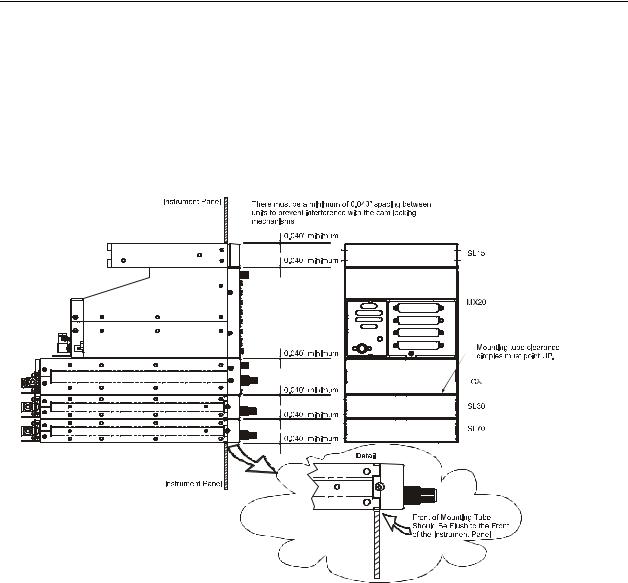
Installation
dimples help maintain the proper clearance. The mounting tube must be installed with the clearance dimples pointing up.
The mounting tube should be flush to the instrument panel and allow sufficient clearance for the back of the bezel of the unit to mount flush to the mounting tube. Sufficient clearance must exist in the instrument panel opening to allow ease of insertion and removal of the unit. If the back of the unit bezel does not mount flush to the mounting tube, the connector may not engage fully.
Figure 2 - Full Stack Mounting Tube Spacing
Secure the mounting tube to the instrument panel structure. Mounting screw heads must not protrude into the mounting tube. Be sure to use the appropriate screws so the unit will slide in and out freely. The screws attaching the mounting tube to the instrument panel structure must not interfere with the insertion of the unit. Failure to prevent interference will result in damage to the unit or prevent its insertion. Take care that the mounting tube is not distorted when it is attached to the instrument panel and structural supports. Shims may be necessary to properly install the mounting tube. If the mounting tube is distorted out of square, the unit may either bind when being inserted or the cam lock may not engage.
Apollo SL30 Installation Manual |
11 |
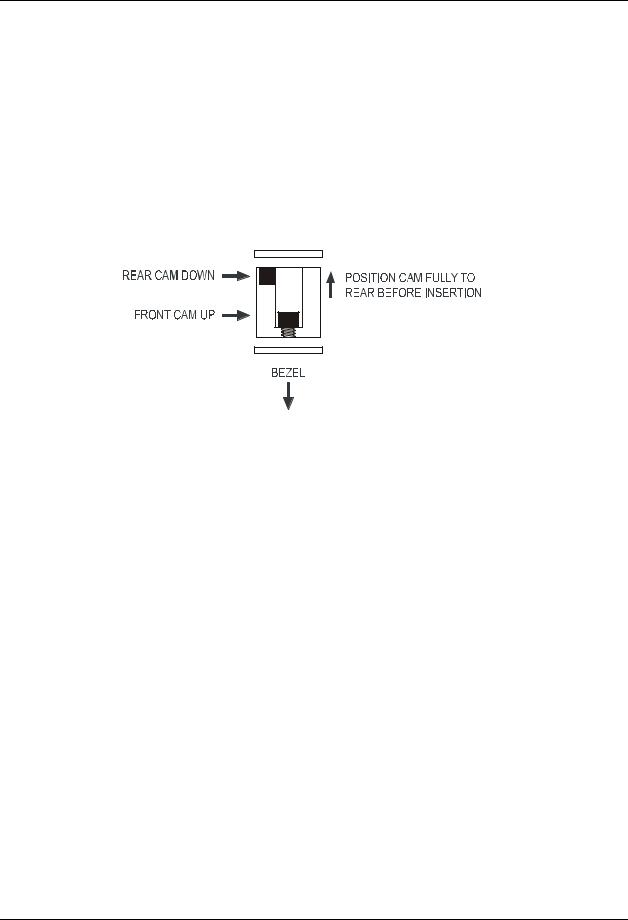
Installation
UNIT INSERTION
Position the cam lock as shown below. The front lobe of the cam should be vertical. The cam lock mechanism should be fully unscrewed (turned counter-clockwise). Slide the unit into the frame. Turn (clockwise) and carefully hand-tighten (4 in-lb max.) the cam lock mechanism using only the 3/32" hex driver provided in the installation package. Using a larger tool than the one provided makes it easy to exceed the allowable torque on the cam lock resulting in damage to the unit. The unit will be pulled into the frame securing the unit and the connectors when fully engaged. Do NOT overtighten. The back of the bezel must be flush to the mounting tube. If the cam lock is hard to turn or the unit does not seat fully, the unit is probably binding and the mounting tube should be checked.
Figure 3 - Cam Lock Positioning
UNIT REMOVAL
To remove the unit from the mounting frame, turn the screw counter-clockwise with the hex driver to unscrew the cam lock mechanism. The unit will begin to pull away from the mounting tube. Turn the screw until slight resistance is felt and then pull the unit from the frame. Do not exert excessive turning force at the end of the cam lock travel or the unit may be damaged. With the cam lock fully disengaged, pull the unit straight out holding onto the sides of the bezel. It is not recommended that you pull the unit out by the rotary knobs. No special extraction tools are required, if the mounting tube is properly installed.
12 |
Apollo SL30 Installation Manual |

Installation
Figure 4 - Mounting Frame Assembly
Figure 5 - Cable Routing
Apollo SL30 Installation Manual |
13 |

Installation
ELECTRICAL CONNECTIONS
The SL30 installation kit includes 15and 37-pin d-sub shells and crimp contacts. The crimp contacts are specified for 20 to 24 awg wire. Make the crimp connections with a crimp tool as specified on page 6. All wires should be 20 to 24 AWG unless otherwise specified. Wiring diagrams are included in this section.
POWER
The SL30 requires two power connections, one for the Nav side of the unit, the other for the Comm. Make the power connections to the unit using 20 awg wire.
The Comm power input is internally fused at 7 amps. A separate 5 amp circuit breaker or fuse should be installed for downline overload or short circuit protection.
The NAV internal fuse is 3 amps. A separate 2 amp circuit breaker or fuse should be installed for downline overload or short circuit protection.
Note: Circuits should be protected in accordance with guidelines in AC 43.13-1B, chapter 11, section 4.
Warning
When connecting power to the unit, reversing the polarity of the connection will blow the internal fuse. The internal fuse requires replacement at the factory or factory authorized repair center.
AVIONICS OUTPUTS
The SL30 includes a complete avionics interface for resolvers, CDI/HSI indicators, autopilot, and back course annunciator. These outputs are to be connected as appropriate for the particular installation. The CDI/HSI outputs may be connected to a dedicated CDI or HSI or to a shared indicator using an appropriate switching relay, such as an Apollo ACU. The avionics outputs available are listed in the Avionics Outputs specification on page 42. Connect the annunciator outputs as necessary.
SERIAL INTERFACE
The SL30 includes an RS-232 serial port for making optional connections. The serial port can be used for connecting to:
•Resolvers, indicators, or electronic flight instruments that accept serial data
•GX series units for Comm/NAV frequency transfers from the database
•MX20 to display VOR data on a map and database interface
•RMI/DME control box allows DME tuning, DME display, and OBI output
When making connections to the SL30, use a three conductor shielded cable. Make RxD, TxD, and signal ground connections to the 37-pin connector. Connect the shield(s) to the rear of the mounting frame on the connector plate. The shield leads must be < 1.25 inches.
Complete serial interface specifications are included in Appendix E – Serial Interface Specifications.
SPEAKER AND HEADPHONE OUTPUTS
Connect the speaker and headphones to the output pins on the rear connector.
14 |
Apollo SL30 Installation Manual |

Installation
MICROPHONE INPUTS
Microphone input connections should be made using a twisted pair shielded cable. Attach the signal ground to the mic ground pin on the rear connector and connect the shield to the rear connector plate.
TRANSMIT KEY INPUT
The TxKey input on the rear connector must be pulled low to ground to enable the transmitter. This input should be connected to a microphone or yoke mounted momentary push button switch.
INTERCOM SELECTOR SWITCH
The SL30 includes a voice activated intercom function that can be enabled by an external control switch. This is an optional connection.
When making connection for the intercom selection, connect the intercom selection input to a remote mounted normally open switch (an alternate action switch can be used). Connect the other terminal of the switch to ground. The intercom function is enabled when the input is pulled low to ground.
REMOTE FLIP/FLOP INPUT
The SL30 includes a remote flip/flop input. This is an optional input that can be connected to a remote mounted (such as on the yoke) momentary push button switch which pulls the input low to ground. The remote flip/flop input will only toggle the Comm frequencies when Comm frequencies are displayed and will only toggle NAV frequencies when NAV frequencies are displayed.
ANTENNA INSTALLATION AND CONNECTIONS
COMM AND NAV ANTENNAS
The SL30 requires a standard 50Ω vertically polarized Comm antenna and a horizontally polarized NAV/VOR/Localizer/Glideslope antenna. Follow the antenna manufacturer’s installation instructions for mounting the antennas. The Comm antenna should be a standard Comm antenna that operates on Comm frequencies between 118.00 and 137.000 MHz. The NAV antenna should be a VOR/Localizer/Glideslope NAV antenna that receives VOR frequencies between 108 and 117.95 MHz, and localizer frequencies between 108 and 112 MHz and glideslope information between 328.6 and 335.4 MHz.
The NAV and Comm antennas should also be mounted as far apart as practical from the ELT antenna, preferably one on top and the other on the bottom of the aircraft fuselage. Some ELTs have exhibited re-radiation problems generating harmonics that may interfere with GPS signals. This can happen when the Comm (SL40 or any other Comm) is transmitting on certain frequencies such as 121.15 or 121.175 MHz, which may cause the ELT output circuit to oscillate from the signal coming in on the ELT antenna coax.
The antenna coax cable should be made of RG-142B or a comparable quality 50Ω coax. Assembly instructions for the rear coax connector are included in Figure 6.
Apollo SL30 Installation Manual |
15 |
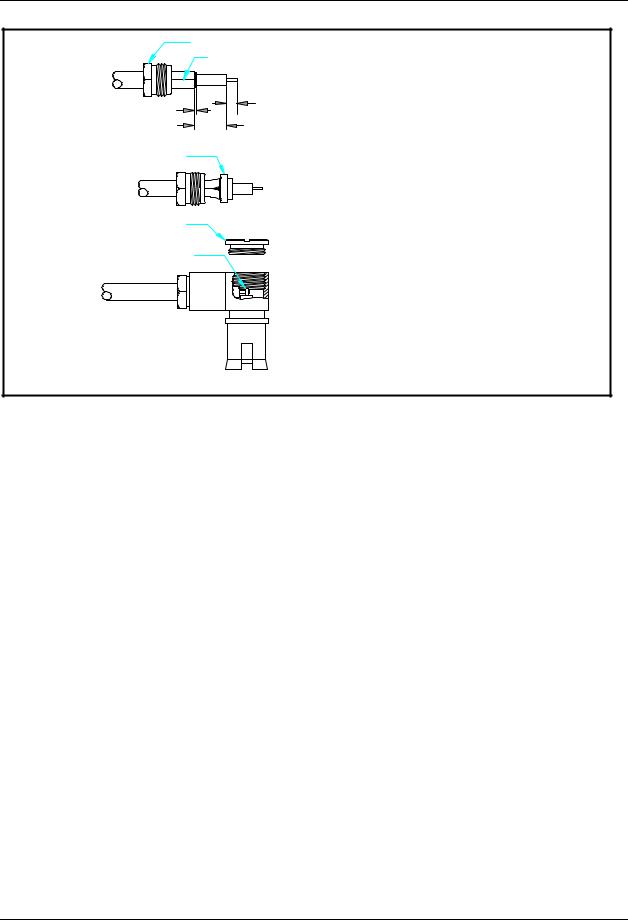
Installation
Step 1.
Step 2.
|
Clamp Nut |
|
Slit 1/4" (2X) |
0.031 |
0.125 |
|
|
|
0.375 |
Braid Clamp
Cap
-Slide clamp nut over coax.
-Strip coax as illustrated.
-Cut two 1/4" slits in jacket 180 degrees apart.
-Slide braid clamp over end of coax and under the braid.
Step 3.
Solder Center
Conductor
- Insert coax with braid clamp into connector and tighten clamp nut securely.
-Solder the center conductor of the coax to the contact as illustrated.
-Attach the cap and secure tightly.
Assembly instructions for right angle connector part #162-1008
Figure 6 - Rear Coax Connector Assembly
USE OF SPLITTER AND COMBINER
The SL30 is the smallest, most advanced NAV/Comm unit on the market. Its size dictates room for only one Comm antenna input and one NAV antenna input. It incorporates an internal diplexor circuit. This means that the input VHF signal must not strip the glideslope (330 MHz) signal from the NAV (108 MHz) signal. Do not install an external diplexor.
It is recommended that a single VOR/Localizer/Glideslope antenna be used for the installation. Most VOR/LOC-only antennas will still provide an adequate glideslope signal for the Apollo SL30 to operate normally. In rare cases, it may be necessary to combine antenna signals. When the signals are combined, the systems overall performance may be slightly degraded, but the glideslope signal may increase to an acceptable level.
Dual Antennas
If separate VOR and glideslope antennas are used on the aircraft, a splitter/combiner must be used.
VOR/LOC Antenna |
|
1 |
Splitter/ |
S |
|
SL30 NAV Input |
|
|
|||||
|
|
|
|
|||
GS Antenna |
|
2 Combiner |
|
|||
|
|
|
|
|||
16 |
Apollo SL30 Installation Manual |

Installation
Dual SL30s
If dual SL30s are installed in the aircraft, a splitter must be used.
VOR/LOC/GS Antenna |
|
S |
Splitter/ 1 |
|
|
|
|||
|
Combiner 2 |
|
||
|
|
|
|
SL30 #1
SL30 #2
Dual Antennas and Dual SL30s
If dual SL30s and separate VOR and glideslope antennas are installed in the aircraft, a combiner and a splitter must be used.
VOR/LOC Antenna |
|
1 |
Splitter/ |
S |
|
S |
Splitter/ |
1 |
|
SL30 #1 |
|
|
|
||||||||
|
|
|
|
|
|
|
||||
GS Antenna |
|
2 Combiner |
|
Combiner 2 |
|
SL30 #2 |
||||
|
|
|
||||||||
|
|
|
|
|
||||||
Installations should use an appropriate splitter/combiner, such as the Mini-Circuits ZFSC-2- 1B BNC, available as an option under the Garmin AT part number 115-0007. This unit has been fully environmentally qualified for use with single and dual SL30 installations.
EQUIPMENT INTERFACE
Figure 12 through Figure 22 illustrate typical equipment configurations. SL30 installation is not limited only to equipment shown. The installer must ensure each article interfaced to the SL30 meets the interface specification listed in this manual.
Apollo SL30 Installation Manual |
17 |
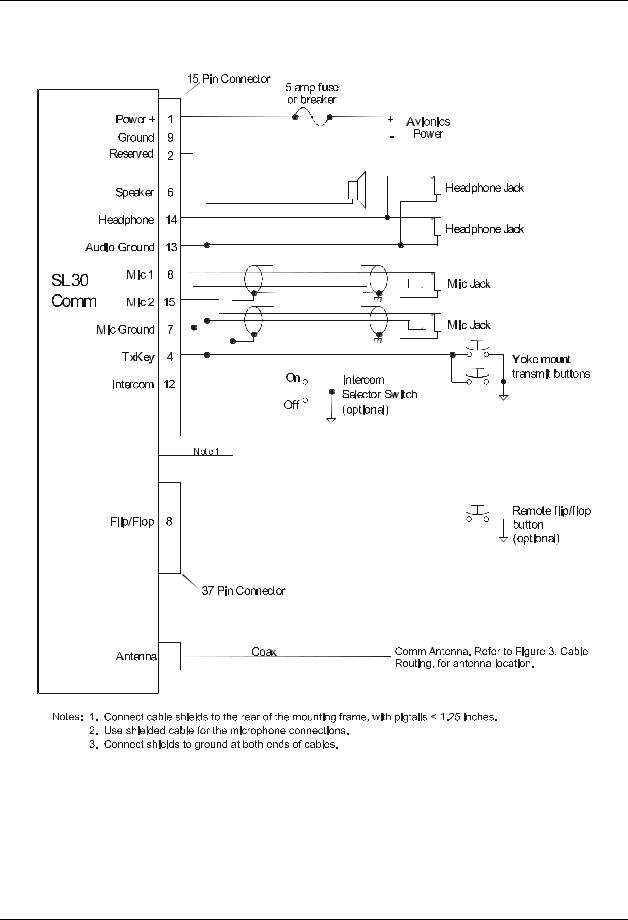
Installation
Figure 7 - SL30 Comm Wiring Diagram
18 |
Apollo SL30 Installation Manual |
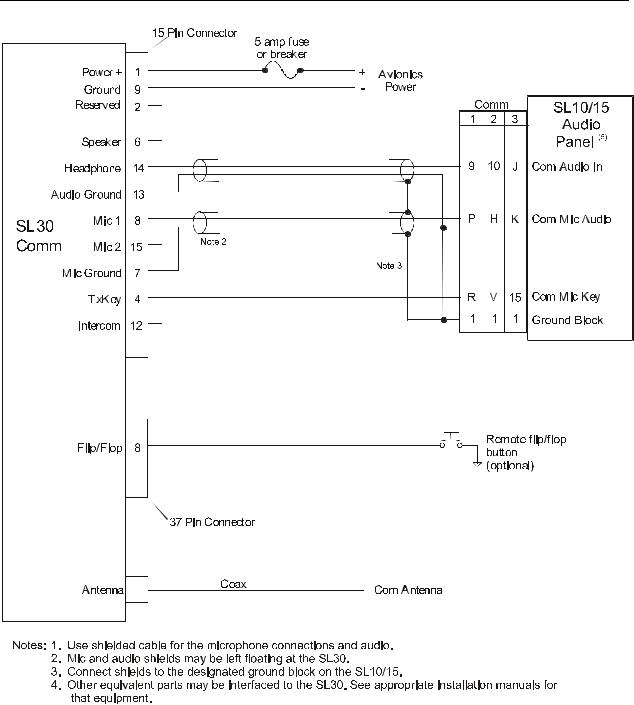
Installation
Figure 8 - SL30 Comm Typical Audio Panel Connections
Apollo SL30 Installation Manual |
19 |
